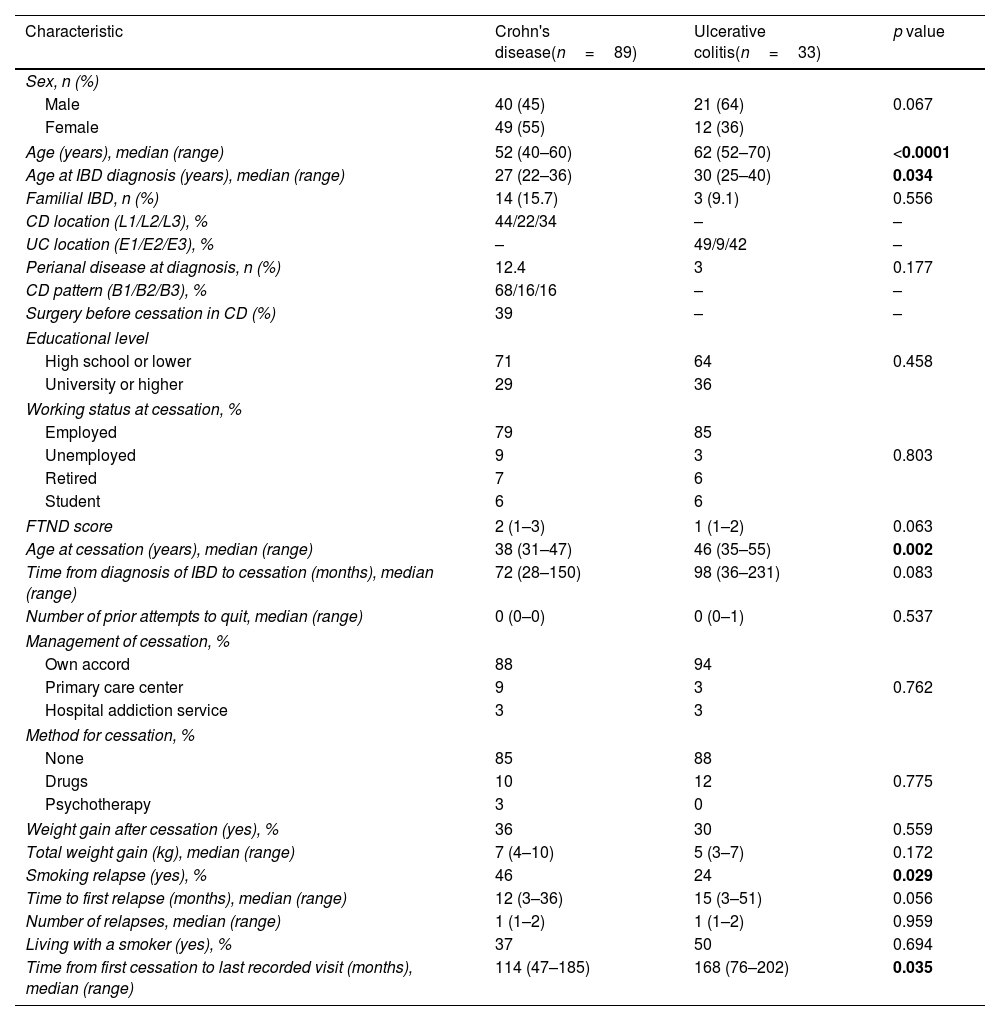Smoking can worsen inflammatory bowel disease (IBD), although evidence regarding the duration of cessation is scarce. The objectives of the study were to determine the duration of abstinence and identify the characteristics of relapse in IBD patients.
Patients and methodsUsing the local database of a nationwide registry of patients with IBD, we identified patients who were active smokers at the time of IBD diagnosis and invited them to participate in the study. Patients were asked about their smoking habit and those who were ex-smokers constituted the study cohort. We obtained clinical and smoking-related data of ex-smokers from medical records and telephone interviews. We measured nicotine dependence using the Fagerström Test for Nicotine Dependence (FTND).
ResultsWe enrolled 121 IBD patients who were ex-smokers: 89 patients with Crohn's disease (CD) and 33 patients with ulcerative colitis (UC). The median age at cessation was lower in patients with CD (38 years) than in patients with UC (46 years) (p=0.002). Follow-up time was shorter in CD patients than in UC patients (114 vs. 168 months, p=0.035). No difference was found in the FTND score. Relapse was more common in CD patients (46%) than in UC patients (24%) (p=0.029), although time to first relapse was similar in both groups of patients (12 and 15 months, respectively; p=0.056). Nicotine dependence was the only independent factor associated with relapse.
ConclusionsThe risk of smoking relapse was high, especially in CD patients, although their dependence level was similar to that of UC patients.
El hábito tabáquico puede empeorar la enfermedad inflamatoria intestinal (EII). Sin embargo, hay pocos datos sobre la duración del abandono del tabaco. Los objetivos del estudio fueron determinar la duración de la abstinencia y definir las características de la recaída en pacientes con EII.
Pacientes y métodosUtilizando la base de datos local de un registro nacional de pacientes con EII, se identificó a los pacientes que eran fumadores activos en el momento del diagnóstico y se les invitó a participar en el estudio. Se les preguntó por su hábito tabáquico; los pacientes considerados exfumadores constituyeron la cohorte del estudio. Se obtuvieron los datos clínicos y de abandono del hábito tabáquico de los pacientes exfumadores mediante la revisión de las historias clínicas y una entrevista telefónica. El grado de dependencia de la nicotina se midió con el test de Fagerström para la dependencia de la nicotina (FTND).
ResultadosParticiparon 89 pacientes con enfermedad de Crohn (EC) y 33 pacientes con colitis ulcerosa (CU). La mediana de edad al abandono fue menor en los pacientes con EC (38 años) que en los pacientes con CU (46 años) (p=0,002). El seguimiento fue más corto en los pacientes con EC que en aquellos con CU (114 vs. 168 meses; p=0,035). No se encontraron diferencias en la puntuación del FTND. La recaída fue más frecuente en los pacientes con EC (46%) que en los pacientes con CU (24%) (p=0,029), aunque el tiempo hasta la primera recaída fue similar en ambos grupos de pacientes (12 y 15 meses, respectivamente; p=0,056). La dependencia de la nicotina fue el único factor independiente asociado con la recaída.
ConclusionesEl riesgo de recaída en el hábito tabáquico fue alto, especialmente en pacientes con EC, aunque su nivel de dependencia fue similar al de los pacientes con CU.










